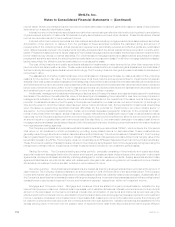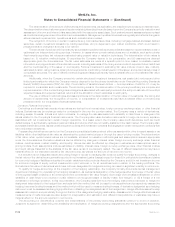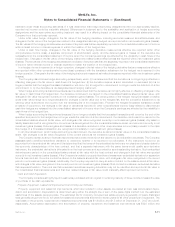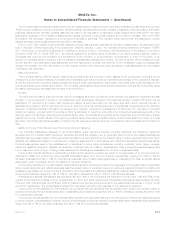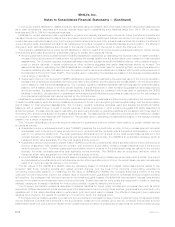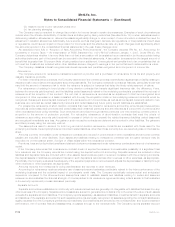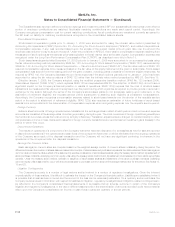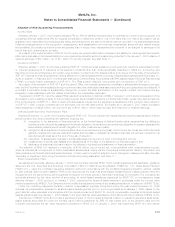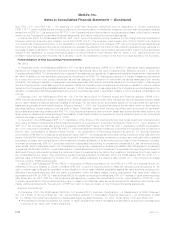MetLife 2007 Annual Report Download - page 113
Download and view the complete annual report
Please find page 113 of the 2007 MetLife annual report below. You can navigate through the pages in the report by either clicking on the pages listed below, or by using the keyword search tool below to find specific information within the annual report.assets meeting such criteria at their fair value. Investment performance (including investment income, net investment gains (losses) and
changes in unrealized gains (losses)) and the corresponding amounts credited to contractholders of such separate accounts are offset
within the same line in the consolidated statements of income.
The Company’s revenues reflect fees charged to the separate accounts, including mortality charges, risk charges, policy administration
fees, investment management fees and surrender charges. Separate accounts not meeting the above criteria are combined on a
line-by-line basis with the Company’s general account assets, liabilities, revenues and expenses.
Employee Benefit Plans
Certain subsidiaries of the Holding Company (the “Subsidiaries”) sponsor and/or administer various plans that provide defined benefit
pension and other postretirement benefits covering eligible employees and sales representatives. A December 31 measurement date is
used for all of the Subsidiaries’ defined benefit pension and other postretirement benefit plans.
Pension benefits are provided utilizing either a traditional formula or cash balance formula. The traditional formula provides benefits
based upon years of credited service and either final average or career average earnings. The cash balance formula utilizes hypothetical or
notional accounts which credit participants with benefits equal to a percentage of eligible pay as well as earnings credits, determined
annually based upon the average annual rate of interest on 30-year Treasury securities, for each account balance. As of December 31,
2007, virtually all the obligations are calculated using the traditional formula.
The Subsidiaries also provide certain postemployment benefits and certain postretirement medical and life insurance benefits for retired
employees. Employees of the Subsidiaries who were hired prior to 2003 (or, in certain cases, rehired during or after 2003) and meet age
and service criteria while working for one of the Subsidiaries, may become eligible for these other postretirement benefits, at various levels,
in accordance with the applicable plans. Virtually all retirees, or their beneficiaries, contribute a portion of the total cost of postretirement
medical benefits. Employees hired after 2003 are not eligible for any employer subsidy for postretirement medical benefits.
SFAS No. 87, Employers’ Accounting for Pensions (“SFAS 87”), as amended, established the accounting for pension plan obligations.
Under SFAS 87, the projected pension benefit obligation (“PBO”) is defined as the actuarially calculated present value of vested and non-
vested pension benefits accrued based on future salary levels. The accumulated pension benefit obligation (“ABO”) is the actuarial present
value of vested and non-vested pension benefits accrued based on current salary levels. Obligations, both PBO and ABO, of the defined
benefit pension plans are determined using a variety of actuarial assumptions, from which actual results may vary, as described below.
SFAS No. 106, Employers’ Accounting for Postretirement Benefits Other than Pensions (“SFAS 106”), as amended, established the
accounting for expected postretirement plan benefit obligations (“EPBO”) which represents the actuarial present value of all other
postretirement benefits expected to be paid after retirement to employees and their dependents. Unlike for pensions, the EPBO is not
recorded in the financial statements but is used in measuring the periodic expense. The accumulated postretirement plan benefit
obligations (“APBO”) represents the actuarial present value of future other postretirement benefits attributed to employee services rendered
through a particular date and is the valuation basis upon which liabilities are established. The APBO is determined using a variety of
actuarial assumptions, from which actual results may vary, as described below.
Prior to December 31, 2006, the funded status of the pension and other postretirement plans, which is the difference between the fair
value of plan assets and the PBO for pension plans and the APBO for other postretirement plans (collectively, the “Benefit Obligations”),
were offset by the unrecognized actuarial gains or losses, prior service cost and transition obligations to determine prepaid or accrued
benefit cost, as applicable. The net amount was recorded as a prepaid or accrued benefit cost, as applicable. Further, for pension plans, if
the ABO exceeded the fair value of the plan assets, that excess was recorded as an additional minimum pension liability with a
corresponding intangible asset. Recognition of the intangible asset was limited to the amount of any unrecognized prior service cost.
Any additional minimum pension liability in excess of the allowable intangible asset was charged, net of income tax, to accumulated other
comprehensive income.
As described more fully in “Adoption of New Accounting Pronouncements”, effective December 31, 2006, the Company adopted
SFAS No. 158, Employers’ Accounting for Defined Benefit Pension and Other Postretirement Plans — an amendment of FASB Statements
No. 87, 88, 106, and SFAS No. 132(r) (“SFAS 158”). Effective with the adoption of SFAS 158 on December 31, 2006, the Company
recognizes the funded status of the Benefit Obligations for each of its plans on the consolidated balance sheet. The actuarial gains or
losses, prior service costs and credits, and the remaining net transition asset or obligation that had not yet been included in net periodic
benefit costs as of December 31, 2006 are now charged, net of income tax, to accumulated other comprehensive income. Additionally,
these changes eliminated the additional minimum pension liability provisions of SFAS 87.
Net periodic benefit cost is determined using management estimates and actuarial assumptions to derive service cost, interest cost,
and expected return on plan assets for a particular year. Net periodic benefit cost also includes the applicable amortization of any prior
service cost (credit) arising from the increase (decrease) in prior years’ benefit costs due to plan amendments or initiation of new plans.
These costs are amortized into net periodic benefit cost over the expected service years of employees whose benefits are affected by such
plan amendments. Actual experience related to plan assets and/or the benefit obligations may differ from that originally assumed when
determining net periodic benefit cost for a particular period, resulting in gains or losses. To the extent such aggregate gains or losses
exceed 10 percent of the greater of the benefit obligations or the market-related asset value of the plans, they are amortized into net
periodic benefit cost over the expected service years of employees expected to receive benefits under the plans.
The obligations and expenses associated with these plans require an extensive use of assumptions such as the discount rate,
expected rate of return on plan assets, rate of future compensation increases, healthcare cost trend rates, as well as assumptions
regarding participant demographics such as rate and age of retirements, withdrawal rates and mortality. Management, in consultation with
its external consulting actuarial firm, determines these assumptions based upon a variety of factors such as historical performance of the
plan and its assets, currently available market and industry data, and expected benefit payout streams. The assumptions used may differ
materially from actual results due to, among other factors, changing market and economic conditions and changes in participant
demographics. These differences may have a significant effect on the Company’s consolidated financial statements and liquidity.
F-17MetLife, Inc.
MetLife, Inc.
Notes to Consolidated Financial Statements — (Continued)



